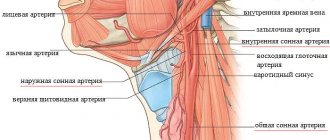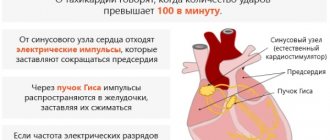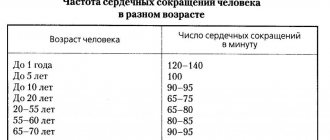What is a normal heart rate in children?
For each age, there are certain indicators that can be checked in pediatric cardiology in Saratov. During the appointment, the doctor listens to the heart, determines or excludes the presence of murmurs, and also counts the number of heartbeats. If necessary, an ECG or ultrasound of the heart may be prescribed. An experienced pediatric cardiologist in Saratov will draw the attention of parents to the fact that the heart rate decreases every year. If at birth 150-160 heart beats are considered normal, then by the age of 12–13 years this number is equal to 75 beats.
The pulse rate directly shows how the heart copes with its function and how efficiently it pumps blood. If there are too many contractions, the heart muscle may become fatigued and heart failure may develop.
Diagnostics
The task of a cardiologist who examines a child with suspected tachycardia is to make sure that the signs he has do not indicate other diseases, for example, bronchial asthma. Also during the examination, he looks for the cause of the disease. To do this, the specialist uses:
- ECG and daily monitoring to analyze how the heart rhythm changes during the normal activity of a small patient;
- EchoCG and MRI to make sure there are no heart pathologies;
- an electrophysiological study to check how the electrical impulse travels through the heart muscle;
- laboratory methods: urine, blood analysis;
- EEG of the brain to make sure that the activity of the central nervous system is not impaired.
Why is it important to monitor your heart rate?
When visiting pediatric cardiology in Saratov, the specialist will pay attention to the fact that sometimes too high a pulse rate does not provoke painful sensations. It is extremely important to monitor the child’s behavior and reaction after physical activity, as well as after emotional outbursts. A small patient may complain of shortness of breath, headache, pain in the sternum radiating to the arm, as well as severe fatigue after:
- active physical exercise;
- long walks at a calm rhythm;
- walking up to low floors.
An increased heart rate in a child can also be observed after emotional stress. A pediatric cardiologist in Saratov will explain that laughter, as well as tears, prolonged viewing of cartoons, and strong emotional reactions can cause an increase in heart rate. It is important to measure the indicators after such a condition, and in addition, parents must make a lot of effort to check the frequency of contractions in the usual way.
Tachycardia in children and adolescents
The word "tachycardia" is literally translated as "fast heart." It can be a symptom of many diseases of the cardiovascular system or a sign of changes in the human body.
Tachycardia in children is quite dangerous, since it concerns the organ that is most important for human life. The most common tachycardia in children is sinus, in which the number of heart contractions in the sinus node increases. Rapid heartbeat in childhood can occur due to excessive physical exertion or as a harbinger of some kind of heart or vascular disease.
There is also paroxysmal tachycardia, in which the heart rate increases sharply and can become two or even three times greater. But chronic tachycardia in children is considered more dangerous. Its signs are low blood pressure, a feeling of suffocation, chest pain, as well as loss of consciousness and convulsions. This type of disease can torment a child for years, but in most cases it should be treated not with medications, but simply with lifestyle changes.
In general, fast heartbeat of any type in children should be treated with whatever means the doctor recommends, since it can develop and even lead to a disease such as heart failure.
Particular attention should be paid to the heart rate regimen in adolescents. After all, a lot of changes occur in their body. Tachycardia in adolescents is often a signal by which the body tries to communicate that it cannot keep up with the changes that are happening to it and cannot cope with them. Complications in such cases do not occur often, but it is still worth paying attention to this problem.
Such tachycardia must be treated comprehensively. First of all, you need to normalize your daily routine, in which it is advisable to go to bed and get up at the same time. It is also worth engaging your teenager in special gymnastics; it is necessary to strengthen the heart. It is also worth taking measures regarding the time spent outside. It is necessary to distract your son or daughter from the computer and offer to take a walk in the fresh air.
Tachycardia in adolescents and children is most often not too serious, but everything must be done to get rid of it and bring the hearts of children of any age back to normal. Identifying this disease earlier is very important in cases where tachycardia is a harbinger of other diseases of the cardiovascular system.
Why does the heart rate increase?
During emotional or physical stress, adrenaline is released, which irritates the cerebral cortex. The hormone cortisol may also be released. Its excess causes insomnia and an overly alert state. It is especially dangerous if the child's heart rate increases in the evening, when he should lie down, relax and fall asleep. Adrenaline, entering the blood, causes its increased speed, and the heart begins to pump blood faster, which means it works with increased load.
Additional reasons why the heart rate may increase include:
- infectious and viral diseases suffered by a woman during pregnancy,
- natal injuries;
- acute illnesses of a child with increased body temperature;
- undergone surgical interventions.
A pediatric cardiologist in Saratov often diagnoses palpitations, other types of heart rhythm disturbances, heart murmurs, and blood pressure fluctuations. These symptoms can be caused by both diseases of the heart and blood vessels, and a number of other conditions: disturbances in the functioning of the endocrine system, nervous system, and kidneys. To identify the cause of the disease, a complete examination is required.
Sometimes for such an examination in pediatric cardiology in Saratov, the Holter heart rate monitoring method is prescribed, with the help of which the heart rate is recorded for 24 hours. Over the course of a day, a child’s emotional background and mood changes, there is physical activity, periods of sleep and quiet activities, and academic workload, which affects the functioning of the heart. And when deciphering the recording of the circadian rhythm, the pediatric cardiologist in Saratov sees what changes have occurred in the work of the heart.
Features of pediatric sinus tachycardia
Content
Sinus tachycardia in children is when the heart beats too fast when there is an acceptable sinus rhythm. A sign of it is a pulse of more than 100 beats per minute for adults. In children, the bar above which the heart rate is considered abnormal depends on age. The older the child, the lower the threshold beyond which pathology is determined.
Causes of this disease
The causes of heart palpitations are slightly different in infants and adolescents. If we talk about newborns, their heart rate increases greatly due to the fact that the automaticity of the sinus node is increased. The specific reasons are as follows:
- physiological reasons: overheating, swaddling, pain, anxiety, examination;
- pathology;
- myocarditis;
- hypoglycemia;
- damage to the central nervous system.
This syndrome is a benign condition in newborns.
If a baby has sinus tachycardia for a long period of time, myocardial metabolism may be disrupted. However, most often for newborns, the syndrome we are discussing is a benign condition. The reasons why sinus tachycardia occurs in adolescents are somewhat different:
- age-related characteristics, for example, strong growth of the body;
- emotional stress;
- diseases, endocrine, cardiovascular and so on;
- physical stress.
Types and symptoms
Sinus tachycardia can be of three types:
- Moderate, in which the heart rate increases by no more than 20 percent;
- Average, characterized by an increase in rhythm by no more than 40 percent;
- Pronounced – increase in rhythm up to 60 percent.
Symptoms of tachycardia are as follows:
- palpable episodes of increased heart rate;
- pain in the heart area;
- weakness;
- dizziness;
- dyspnea:
- fainting;
- fast fatiguability.
Diagnosis and treatment
Diagnostics includes a number of methods.
- ECG. Using it, it is easy to determine the frequency and rhythm of heart contractions in both infants and adolescents.
A nurse performs an ECG
- Daily ECG monitoring. The method is informative and safe for both infants and adolescents.
- Echo CG is performed to determine sinus pathology that can affect the heart.
- Electrophysiological study of the heart. Allows you to find out the mechanism of tachycardia and cardiac conduction disturbances.
- General blood analysis
- Determination of thyroid-stimulating hormones in the blood.
- EEG of the brain. It is with the help of this study that blood disease and central nervous system pathology can be excluded.
- Open access to fresh air into the room; it is better to go outside by loosening the collar of your shirt or sweater. The neck should be free.
- Place a cold, wet towel or handkerchief on your forehead.
If you witness an attack of tachycardia in a child, you must:
Treatment can only be prescribed by a doctor
If this does not bring relief, be sure to call a doctor. In most cases, the disease goes away on its own. The increased heart rate resulting from high temperature returns to normal after it decreases. Treatment of childhood tachycardia by doctors involves taking sedatives based on medicinal herbs. Only a cardiologist, knowing the medical history, can select individual treatment methods that are suitable for each patient. They are based on certain principles.
- In case of sinus disease of a neurogenic nature, you need to consult a neurologist, who will certainly prescribe his own treatment.
- It is worth distinguishing between reflex tachycardia (with hypovolemia) and compensatory tachycardia (anemia, iron deficiency). To do this, it is necessary to eliminate the causes of sinus disease.
- If a patient has endocrine disorders, they can be eliminated by an endocrinologist, to whom the patient goes for a consultation.
- If tachycardia is associated with cardiac dysfunction, the cardiologist prescribes cardiac glycosides.
Prevention
Preventive measures include three main principles.
- Early diagnosis. The earlier this disease is detected, the sooner a treatment method will be prescribed.
Critical age periods
For young patients, there are critical periods during which an elevated heart rate is often observed. Most often, the child cannot explain exactly how bad he feels and what is the reason for such physiological changes. He feels pressure in his chest, dizziness, sometimes chills, and may even lose consciousness. You should not allow such frequent reactions to occur, and you should visit a pediatric cardiologist in Saratov as soon as you notice the first symptoms. A small patient may be afraid that his body reacted this way to running, watching his favorite movie and the fact that he received a gift that he had dreamed of for so long.
Symptoms
In addition to palpitations, cardiac tachycardia in children manifests itself:
- chest pain;
- shortness of breath;
- dizziness and fainting;
- lethargy and pallor;
- nausea;
- sweating
At such moments, infants become restless and capricious, refusing to eat and sleep. It is important to consult a doctor as soon as you notice the first signs of illness. If tachycardia in children is not treated, the severe pathologies that caused it will lead to serious complications:
- arrhythmogenic shock;
- pulmonary edema;
- heart failure;
- cardiac arrest.
What are the future risks of a high pulse?
If you do not notice in time and do not contact pediatric cardiology in Saratov for adequate treatment, the child will experience frequent painful sensations over time, and in addition, he may develop associated disorders:
- with vessels, veins and arteries;
- with the nervous system;
- with hormonal background.
A pediatric cardiologist in Saratov, based on the monitoring results and tests obtained, will determine and make an accurate diagnosis, which will allow you to prescribe treatment, the effectiveness of which will not be long in coming. It is also important to record changes after a certain time in order to adjust the medication course and prescribe additional physiotherapeutic procedures, and choose the appropriate sport. It is important to take measurements immediately after physical activity of varying strength and intensity, after strong positive or negative psychological reactions. Pulse rate measurements after sleep are also important for a pediatric cardiologist in Saratov to determine the diagnosis and prescribe effective and appropriate treatment.
Over time, as the child grows up, it is necessary to teach him to monitor his pulse rate, especially after physical or emotional stress. There are drugs that can quickly restore the pulse rate, and in addition, maintenance therapy. Every year a little patient must learn to listen to his body, and an experienced pediatric cardiologist in Saratov will help with this.
Make an appointment with a cardiologist
Choose a doctor
Sinus tachycardia
The causes of sinus tachycardia in adolescents may be neurogenic effects, organic heart damage, or increased thyroid function. An increase in heart rate is said to occur if it becomes more than 80 beats per minute.
The occurrence of neurogenic sinus tachycardia is also based on an imbalance in the autonomic nervous system, expressed in the increased effect of sympathetic innervation on the Kate-Fleck sinus node. In this case, the heart rate can increase to 100-120 beats per minute. Characteristic features of this form of tachycardia are its variability, periodic transition to a normal rhythm, and greater rhythm lability in response to exogenous influences, mainly neuropsychic.
The increase in rhythm is especially pronounced in a standing position, therefore the ortho-clinostatic test for this form of tachycardia is positive, the body temperature is normal, and the general state of health is satisfactory. The diagnosis of neurogenic sinus tachycardia should be approached in a strictly differentiated manner. It is necessary to exclude damage to the cardiovascular system.
Thus, the causes of tachycardia can be acquired and congenital heart defects, of which tachycardia is especially often observed with an open ductus arteriosus, atrial septal defect, etc.
Sinus tachycardia can occur with a small heart; in this case, a decrease in stroke volume causes a compensatory increase in rhythm. Making a diagnosis in all of the above cases does not cause any particular difficulties. It can be more difficult to exclude thyrotoxicosis, especially if thyroid function during testing turns out to be normal, despite its slight increase and the presence of other mild signs of thyrotoxicosis.
In this case, it is necessary to resort to treatment with microdoses of iodine, sometimes ex uvantibus, in order to come to a final conclusion.
“Clinic of diseases, physiology and hygiene in adolescence”, G.N. Serdyukovskaya









